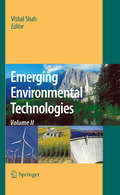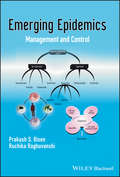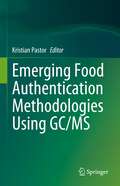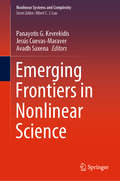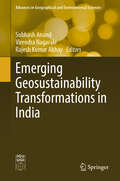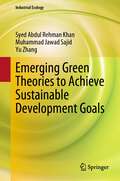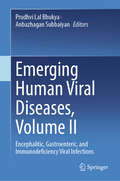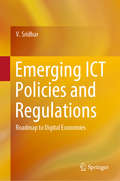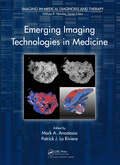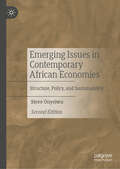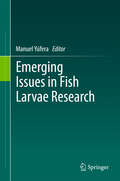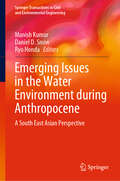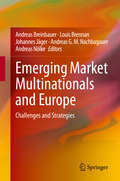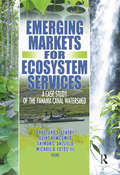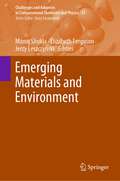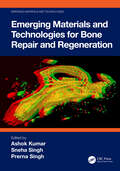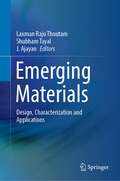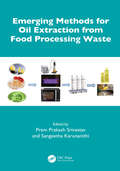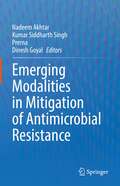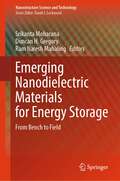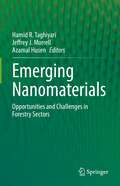- Table View
- List View
Emerging Energy Materials: Applications and Challenges (Series in Materials Science and Engineering)
by Sanjay J. Dhoble Govind B. Nair H. Nagabhushana Nirupama S. DhobleEmerging Energy Materials: Applications and Challenges guides the reader through materials used in progressive energy systems.It tackles their use in energy storage across solar, bio, geothermal, wind, fossil, hydrogen, nuclear, and thermal energy. Specific chapters are dedicated to energy reaping systems currently in development. This book contributes to the current literature by highlighting concerns that are frequently overlooked in energy materials textbooks. Awareness of these challenges and contemplation of possible solutions is critical for advancing the field of energy material technologies.Key features: Provides up-to-date information on the synthesis, characterization, and a range of applications using various physical and chemical methods Presents the latest advances in future energy materials and technologies subjected to specific applications Includes applied illustrations, references, and advances in order to explain the challenges and trade-offs in the field of energy material research and development Includes coverage of solar cell and photovoltaic, hydro power, nuclear energy, fuel cell, battery electrode, supercapacitor and hydrogen storage applications This book is a timely reference for researchers looking to improve their understanding of emerging energy materials, as well as postgraduate students considering a career within materials science, renewable energy and materials chemistry.
Emerging Environmental Technologies, Volume II
by Vishal ShahWhile numerous journals and books are available in the market highlighting the developments in the field of environmental technology, none of them exclusively focuses on the technologies that would be in the forefront in near to far future. Each and every article in the book is peer-reviewed and from a different sub-discipline. Because of its interdisciplinary topics on for instance air pollution and energy production, this makes it a one book for all and serves as an excellent resource for scientists, entrepreneurs, politicians and non-governmental organizations who wish to gain information on upcoming and promising technologies.
Emerging Epidemics: Management and Control
by Prakash S. Bisen Ruchika RaghuvanshiA global perspective on the management and prevention of emerging and re-emerging diseases Emerging infectious diseases are newly identified or otherwise previously unknown infections that cause public health challenges. Re-emerging infectious diseases are due to both the reappearance of and an increase in the number of infections from a disease that is known, but which had formerly caused so few infections that it was no longer considered a public health problem. The factors that cause the emergence or re-emergence of a disease are diverse. This book takes a look at the world's emerging and re-emerging diseases. It covers the diagnosis, therapy, prevention, and control of a variety of individual diseases, and examines the social and behavioral issues that could contribute to epidemics. Each chapter focuses on an individual disease and provides scientific background and social history as well as the current basics of infection, epidemiology, and control. Emerging Epidemics: Management and Control offers five topics of coverage: FUNDAMENTALS Epidemics fundamentals Disasters and epidemics Biosafety RE-EMERGING EPIDEMICS Tuberculosis Plague NEWLY EMERGING EPIDEMICS Leptospirosis Dengue Japanese Encephalitis Chikungunya Fever West Nile Virus Chandipura Virus Encephalitis Kyasanur Forest Disease Hantavirus Human, Avian, and Swine Influenza Severe Acute Respiratory Syndrome Nipah Virus Paragonimiasis Melioidosis POTENTIAL EPIDEMICS Biowarfare and bioterrorism Food contamination and food terrorism Antimicrobial resistance VECTOR CONTROL METHODS Mosquito control Other disease vectors and their control Offering an integrated, worldwide overview of the complexity of the epidemiology of infections, Emerging Epidemics will be a valuable resource for students, physicians, and scientists working in veterinary, medical, and the pharmaceutical sciences.
Emerging Fluorinated Motifs, 2 Volume Set: Synthesis, Properties and Applications
by Dominique Cahard Jun-An MaA must-have resource for all the researchers working in the organofluorine and related fields This timely two-volume set uniquely focuses on emerging fluorinated motifs beyond R-CF3 and R-F, like R-CF2H, R-OCF3, R-SCF3 and R-SF5. It also offers descriptions of the properties, synthesis, and applications of these emerging fluorinated motifs in order to help readers design new chemical entities, while providing new interest for researchers in organofluorine chemistry and new tools for those in other areas. Emerging Fluorinated Motifs: Synthesis, Properties and Applications begins with a description of carbon-linked fluorine-containing groups that include monofluoromethyl and difluoromethyl groups. It then details combinations of heteroatoms, Oxygen, Sulfur, Selenium, Nitrogen, and Phosphorus with fluorine-containing groups, outlining subsections of the most popular current motifs. Fluoroalkyl ethers, thioethers, and the recent blossoming of the SF5 unit is covered. Other chapters look at: selenium-linked fluorine-containing motifs; construction of N?CF2H, N?CF3, N?CH2CF3 motifs; and the synthesis and applications of P¿Rf-containing molecules. -Focuses on the synthesis, properties, and applications of emerging fluorinated motifs -Covers carbon-linked fluorine-containing motifs, oxygen-linked fluorine-containing motifs, sulfur-linked fluorine-containing motifs, and more -Appeals to academic and industrial researchers working in organic chemistry, medicinal chemistry, food chemistry, and materials science -Edited by world-renowned experts in organofluorine chemistry Emerging Fluorinated Motifs is intended for academic research institutes, university libraries, researchers, graduate students, postdoctors, and researchers in the chemical industry.
Emerging Food Authentication Methodologies Using GC/MS
by Kristian PastorThis edited book provides an overview of existing and emerging gas chromatography/mass spectrometry (GC/MS) based methods for the authentication and fraud detection in all major food groups and beverages. Split in four parts, the book opens with a comprehensive introduction into the GC/MS technique and a summary of relevant statistical and mathematical models for data analysis. The main parts focus on the authentication of the main food groups (cereals, dairy products, fruit, meat, etc.) and beverages (e.g., coffee, tea, wine and beer). The chapters in these sections follow a distinct structure describing the nutritional value of the product, common fraud practices, economic implications and relevant biomarkers for the authentication process, such as volatile compounds, fatty acids, amino acids, isotope ratios etc. The final chapter provides an outlook on where the methodologies and the applications may be heading for. Food fraud is serious problem that affects food industries of all kinds, which is why food authentication plays an increasingly important role. This book aims to serve as a knowledge base for all researchers in academia, regulatory laboratories and industry employing GC/MS for food analysis. Due to its comprehensive introduction and consistent structure, it can also serve as an excellent resource for students in food science, food technology, food chemistry and nutrition.
Emerging Frontiers in Nonlinear Science (Nonlinear Systems and Complexity #32)
by Avadh Saxena Jesús Cuevas-Maraver Panayotis G. KevrekidisThis book explores the impact of nonlinearity on a broad range of areas, including time-honored fields such as biology, geometry, and topology, but also modern ones such as quantum mechanics, networks, metamaterials and artificial intelligence. The concept of nonlinearity is a universal feature in mathematics, physics, chemistry and biology, and is used to characterize systems whose behavior does not amount to a superposition of simple building blocks, but rather features complex and often chaotic patterns and phenomena. Each chapter of the book features a synopsis that not only recaps the recent progress in each field but also charts the challenges that lie ahead. This interdisciplinary book presents contributions from a diverse group of experts from various fields to provide an overview of each field’s past, present and future. It will appeal to both beginners and seasoned researchers in nonlinear science, numerous areas of physics (optics, quantum physics, biophysics), and applied mathematics (ODEs, PDEs, dynamical systems, machine learning) as well as engineering.
Emerging Geosustainability Transformations in India (Advances in Geographical and Environmental Sciences)
by Subhash Anand Virendra Nagarale Rajesh Kumar AbhayThis book presents the emerging sustainability concerns for India to achieve holistic development. India is densely populated with scattered natural resources and is engaged in developing technology and its infrastructure. However, India’s sustainability is questioned from the viewpoints of environment, society, economy and politics. As the Sustainable Development Goals (SDGs) aims to achieve a sustainable world by 2030, India has to relook at its current development approaches and make effective policy measures. Geography is an interdisciplinary branch of social science that focuses on the interrelationships among population, natural resources, social linkages, governments and public policy. Within this interdisciplinary concept, the book presents a collection of studies from scholars in India. We ask questions such as, (1) what major geographical approaches and perspectives exist related to sustainability, (2) how socioeconomic and political factors affects sustainability and SDGs, (3) what approach is the most effective from the sustainability perspective, and (4) how we address sustainability issues. The book serves as a valuable reference for those who are concerned with the progress of sustainability in India.
Emerging Green Theories to Achieve Sustainable Development Goals (Industrial Ecology)
by Yu Zhang Syed Abdul Khan Muhammad Jawad SajidThis book opens up a critical dimension to the field of industrial ecology. The book discusses the emerging green theories in industrial ecology and evolving practices adopted by businesses to achieve Sustainable Development Goals. The author(s) identifies valuable lessons to be learned and presents conceptual frameworks and ideas to guide future industrial ecology applications, which are integrated into the triple bottom line approach and have cornerstone value to achieving Sustainable Development Goals. Additionally, the book discusses the relevant economic theories that serve as the foundation for the presented green views. This elaboration of economic ideas reinforces our work's relevance to achieving a green economy. Therefore, this book is essential for industrial ecology scholars and those interested in ensuring an environmentally sustainable future.
Emerging Human Viral Diseases, Volume II: Encephalitic, Gastroenteric, and Immunodeficiency Viral Infections
by Prudhvi Lal Bhukya Anbazhagan SubbaiyanThe second volume of the book Emerging Human Viral Diseases discusses pathogenesis, diagnostics, and therapeutic strategies against viral encephalitis, gastroenteritis, and human immunodeficiency viral infections. The chapters discuss symptoms, diagnostics, and preventive strategies against viral infections. The book also reviews the epidemiology and evolution of viruses causing these infections. It also examines symptoms and strategies for developing novel diagnostics and the vaccine against these viruses. Toward the end, it discusses various biosafety principles for handling emerging viruses and reviews various bioinformatics tools and databases in virology research. This timely book offers valuable resource for the scientists working in the field of emerging viral infections and those involved in preventing, controlling, and managing viral diseases. Inclusively this book will be valuable guide covering most recent scientific progress in emerging human viral diseases and management and will serve as the best resource for undergraduates, graduates, medical professionals, researchers, public health physicians, and national and international health authorities.
Emerging ICT Policies and Regulations: Roadmap to Digital Economies
by V. SridharThis book constructs both educational and research arguments on various dimensions of Information and Communication Technology (ICT) policy and regulation. There has been a paradigm shift in the ICT industry due to convergence of various technologies, the ubiquity of the Internet, the emergence of app economy and the pervasiveness of social media. These pose policy and regulatory challenges in the areas of industry structure, market power of firms, pricing of products and services, interconnection of networks, radio spectrum management, intellectual property rights, data privacy and security.The common thread throughout the different sections of the book is the massive adoption of digitization by individuals, enterprises, governments and societies and the critical role of associated regulation and policy for its success.The book addresses 13 important questions in the areas of: i) Telecom Regulation including bundling of products and services, interconnection, and radio spectrum; (ii) Internet Regulation including governance of the Internet, Net Neutrality, quality of service, and cyber security; (iii) App Economy Regulation including Over The Top communication and broadcast services, ICT platform intermediation, sharing economy, data protection and privacy; and (iv) Emerging Technology Regulation including Artificial Intelligence and Intellectual Property Rights. The book explains technology and related regulatory concepts in an easy-to-read format and includes brief case studies describing the regulatory approaches from different countries. Specific focus is given to the regulatory landscape in India surrounding these questions and the lessons for similar emerging countries.Written in the form of contemporary questions and answers, this unique book appeals to researchers in ICT policy and regulation, regulators and policymakers, as well as students interested in the subject area."The book comprehensively covers the current and emerging policy and regulatory issues relating to ICT, especially as applicable to India. Further, it provides a theoretical framework for analysing each regulatory issue along with practical implications. A good reference for researchers, regulators and policy makers." - Dr R.S. Sharma, Chairman, Telecom Regulatory Authority of India. “This book by Professor Sridhar provides an excellent overview of the challenges that the world faces in coping with the dynamic new emerging digital technologies that affect the way we work, play and communicate with each other. As the internet and mobile telephony becomes more ubiquitous and accessible to everyone regardless of socio-economic class, ICT can be used for good or for mischief. The book lays out the issues of regulating global ICT and policies that governments should adopt to enable its productive and positive use.” - Dr G Anand Anandalingam, Ralph J. Tyser Professor of Management Science, Robert H. Smith School of Business, University of Maryland, U.S.A. “Using problem-centric approach successfully opens the complexity of ICT regulation to a wider audience. Through cleverly chosen topical case examples the book links the problems of Indian and international ICT markets.” - Dr Hämmäinen Heikki, Professor, Department of Communications and Networking, Aalto University, Finland. “Prof Sridhar is a Thought Leader in the Telecom space and I have enjoyed my interaction with him over the years. This book is an excellent compendium looking at the main regulations and policies with reference to the ICT sector. It serves as a ready reckoner for new entrants and professionals alike, providing global and local perspectives on topics that impact the growing Digital Economy.” - P Balaji, Chief Regulatory and Corporate Affairs
Emerging Imaging Technologies in Medicine
by Mark A. Anastasio Patrick La RiviereFrom the discovery of x-rays in 1895 through the emergence of computed tomography (CT) in the 1970s and magnetic resonance imaging (MRI) in the 1980s, non-invasive imaging has revolutionized the practice of medicine. While these technologies have thoroughly penetrated clinical practice, scientists continue to develop novel approaches that promise t
Emerging Issues in Contemporary African Economies: Structure, Policy, and Sustainability
by Steve OnyeiwuHow have the events of the twenty-first century shaped African economies and societies? In this book, Steve Onyeiwu highlights the dynamics, challenges, and opportunities in African economies. He analyzes the socioeconomic and political conditions in Africa, with emphasis on events of the past two decades. Onyeiwu notes that African economies change virtually every minute, and it’s imperative to ensure the information presented is current and accurate. Climate change and the explosion of the youth population have assumed new dimensions, prompting analysts to ponder their implications for the future of African economies. Other significant changes include COVID-19 and recent apprehension about the resilience of democracy throughout the region. The author addresses these complex topics and explains how the skepticism about the endurance of democracy is fueled by economic anxiety, political violence, coup d'états and protests in many parts of Africa. The book includes recent data on key variables and events in the region. In addition to undertaking thorough revisions of the 10 chapters from the first edition, this new edition includes three new chapters on population and youth, COVID-19, and climate change.
Emerging Issues in Fish Larvae Research
by Manuel YúferaThis book deals with the fundamentals of key physiological mechanisms involved in the development and growth of fish larvae. Chapters included show how the environmental and nutritional conditions are affecting the developmental process from its molecular basis and how these same conditions also influence the final characteristics of late larvae and fry. This volume provides recent findings on the importance of environmental rhythms, some specific nutrients and the adequate microbial environment in the developmental processes including recent results of current research projects.
Emerging Issues in the Water Environment during Anthropocene: A South East Asian Perspective (Springer Transactions in Civil and Environmental Engineering)
by Manish Kumar Daniel D. Snow Ryo HondaThis book intends to bring together and integrate the subject matter of water quality. The book covers aspects of water related to climate change, emerging aspects of engineering sciences, bio-geochemical sciences, hydro geochemistry, river management and morphology, social sciences, and public policy. The book covers the role of disruptive innovations in water management, policy formation and impact mitigation strategies. The book includes lab results as well as case studies. It provides recommendations and solutions for policy making and sustainable water management. The chapters in this book deal cohesively with many aspects of the water environment during the Anthropocene era. The contents cover myriad issues, such as land degradation, water scarcity, urbanization, climate change, and disruptive innovation. The book also discusses issues highly pertinent to society and sustainability, such as the prevalence of enteric viruses and pharmaceutical residues as a possible anthropogenic markers in the aquatic environment. The book will prove useful for students, professionals, and researchers working on various aspects of water related concerns.
Emerging Market Multinationals and Europe: Challenges and Strategies
by Andreas Nölke Louis Brennan Johannes Jäger Andreas Breinbauer Andreas G. M. NachbagauerRecently, there have been public concerns about the impact of emerging market multinationals. The expansion of China's multinationals to Europe and the Belt and Road Initiative is a prominent example that has kindled hope but also started to increase awareness of the long-term implications. Based on a systematic analysis of internationalization theories, the role of foreign direct investment and multinational companies combined with in-depth empirical research using case studies in Turkey, Russia, Latin America, Asia and Europe, this timely edited volume addresses opportunities and concerns related to this new trend. It also provides new insights that are highly relevant for scholars, policy makers, regional business agencies and students, as well as the public at large. By focusing on the (potential) impact of the expansion of emerging market multinationals on Europe and by including a long-term perspective, the book offers a fresh perspective on a highly controversial issue.
Emerging Markets for Ecosystem Services: A Case Study of the Panama Canal Watershed
by Bradford S Gentry Quint Newcomer Shimon C Anisfeld Michael A Fotos IiiPractical ideas provided by a case study of the Panama Canal Watershed Exciting opportunities await the use of market mechanisms for protecting forest ecosystems. However, questions remain on how to best apply these mechanisms. Emerging Markets for Ecosystem Services: A Case Study of the Panama Canal Watershed provides an integrated, interdisciplinary methodological approach for evaluating market opportunities for watershed services, carbon sequestration, and biodiversity protection. Using the Panama Canal Watershed as a case study example, this probing resource addresses the main questions often asked about the various practical aspects of the emerging markets for ecosystem services, including quantifying value, payment structure, and equitable distribution of benefits. Environmental issues are often at odds with economic and business concerns. Emerging Markets for Ecosystem Services examines practical strategies to integrate diverse aspects into coherent strategies that benefit all. A scientific overview of the science and current knowledge provides a solid foundation to build policy and positive direction using the Panama Canal Watershed as an example. This unique resource sheds useful light on the challenges and provides insightful recommendations for areas struggling with ecosystem issues and the application of market mechanisms. This text is extensively referenced and includes several tables to clearly illustrate data. Topics in Emerging Markets for Ecosystem Services include: an overview of carbon sequestration in natural forests, exotic plantations, native plantations, and agroforestry systems policy tools to help reduce barriers to selling carbon credits alternatives for increasing demand for land-use-based carbon sequestration actions to encourage land managers to protect water quantity and quality receiving full value of watershed protection approaches to bioprospecti
Emerging Materials and Environment (Challenges and Advances in Computational Chemistry and Physics #37)
by Jerzy Leszczynski Manoj Shukla Elizabeth FergusonThis contributed volume presents chapters integrating experimental and computational advances in materials research and discusses how the potential release of emerging materials would impact the environment. With increasing populations, there is a growing pressure on resources and the environment to provide food, water, and energy. Innovative materials and novel technologies, such as nanocomposite and multifunctional materials, additive manufacturing, and remediation technologies, are constantly being developed to meet these demands. As technologies mature some potentially harmful materials will find their way into the environment. Depending on their environmental persistence, such as “forever chemicals” per- and polyfluoroalkyl substances (PFAS), some of the emerging materials may become a major environmental challenge. This book covers a broad spectrum of topics related to the recent advances and future directions in emerging materials research, molecular simulations, machine learning and QSAR approaches for environmental contaminants, advanced materials for water purification, remediation technologies of PFAS, and life-cycle assessment of materials. It offers an invaluable resource for postgraduate students and researchers in academia, industry, and different laboratories interested in the field.
Emerging Materials and Technologies for Bone Repair and Regeneration (Emerging Materials and Technologies)
by Prerna Singh Ashok Kumar Sneha SinghThis book covers advancements in the field of bone repair and regeneration. It introduces bone development, repair, and regeneration and details different biomaterials and technologies involved in the fabrication and characterization of bone-related scaffolds and implants. The book explores nanotechnological intervention and folklore phytomedicines and their prospects in regenerating bone including major bone related disease conditions, infection, and their tackling via tissue engineering strategies.FEATURES: Covers polymer materials and technologies for bone repair and regeneration based on tissue engineering Defines the interdisciplinary mechanism of bone tissue repair ranging from the fields of material science, nanotechnology, and phytomedicine includes basic sciences, scaffolds, and bone infection Examines fabrication and characterization methods for the bone repair materials Reviews fundamentals of interlinked mechanisms of bone development, repair, and regeneration. This book is aimed at graduate students and researchers in biomedical and tissue engineering and biomaterial sciences.
Emerging Materials: Design, Characterization and Applications
by J. Ajayan Shubham Tayal Laxman Raju ThoutamThis book serves as a quick guide on the latest material systems including their synthesis, fabrication and characterization techniques. It discusses recent developments in different material systems and discusses their novel applications in various branches of science and engineering. The book briefs latest computational tools and techniques that are used to discover new material systems. The book also briefs applications of new emerging materials in various fields including, healthcare, sensors, opto-electronics, high power devices and nano-electronics. This book helps to create a synergy between computational and experimental research methods to better understand a particular material system.
Emerging Methods for Oil Extraction from Food Processing Waste
by Prem Prakash Srivastav Sangeetha KarunanithiEmerging Methods for Oil Extraction from Food Processing Waste is a comprehensive and cutting-edge exploration of sustainable oil extraction practices, catering to professionals and researchers in food science. The book, spanning 13 insightful chapters, intricately reviews the extraction of oil from food processing by-products, including pomace and surplus raw materials. It specifically focuses on emerging non-thermal technologies, offering valuable insights into improving oil extraction rates. The discussions encompass factors influencing extraction rates and suggest processing conditions based on various extraction methods and raw materials. In addition to providing a nuanced understanding of conventional and novel extraction techniques, the text delves into the diverse applications of the extracted oil, ranging from food preservation to fortification and fat replacement. Notably, it covers advanced processing techniques for enhancing oil stability, bioavailability, and bioactivity through emulsion and encapsulation methods. Addressing crucial commercial aspects, the text explores economic feasibility, safety considerations, and consumer acceptability, providing a holistic perspective for successful industrial adaptation. Authored by global specialists, each chapter offers in-depth scientific reports and critical analyses, making this volume an indispensable resource for continuous research and advancement in the dynamic field of food processing.
Emerging Modalities in Mitigation of Antimicrobial Resistance
by Nadeem Akhtar Dinesh Goyal Kumar Siddharth Singh PrernaAntimicrobial resistance (AMR) is one of the deadliest threats to global public health. This book focuses on dynamics in the landscape of AMR while informing about the latest technologies and strategies to mitigate it. The menace of AMR in different niches, routes of penetration across various domains, socio-economic impact, and the need for a 'One Health' approach in mitigating AMR has been emphasized. Factors involved in AMR, underlying mechanisms, and pharmacometrics in developing antimicrobials are highlighted. Emphasis is given to emerging technologies that are sustainable, scalable, and applicable to the global community, such as big data analytics, bioactive agents, phage therapy, and nanotechnology. The book also explores current and alternative treatment strategies to combat AMR, emphasizing the use of nanoparticles to target pathogens and as a viable alternative to antibiotics.
Emerging Nanodielectric Materials for Energy Storage: From Bench to Field (Nanostructure Science and Technology)
by Srikanta Moharana Duncan H. Gregory Ram Naresh MahalingThis contributed volume presents multiple techniques for the synthesis of nanodielectric materials and their composites and examines their applications in the field of energy storage. It overviews various methods for designing these materials and analyses their properties such as mechanical strength, flexibility, dielectric as well as electrical performances for end-user applications such as thin-film flexible capacitors, advanced energy storage capacitors, and supercapacitors. The book gives a special focus on examining the dielectric properties of polymer-based nanomaterials, core-shell structured nanomaterials, and graphene-based polymeric composites among others, and explains the importance of their use in the aforementioned energy storage applications. It provides a great platform for understanding and expanding technological solutions needed for global energy challenges and it is of great benefit to industry professionals, academic researchers, material scientists, engineers, graduate students, physicists, and chemists working in the area of nanodielectrics.
Emerging Nanomaterials for Advanced Technologies (Nanotechnology in the Life Sciences)
by Ram Prasad Hendrik C. Swart Anand Krishnan Balasubramani Ravindran Balamuralikrishnan Balasubramanian Sarojini Jeeva PanchuOver the past decade the world has seen the rise of the fascinating and diverse field currently recognized as nanotechnology. This book covers a broad spectrum of topics within nanotechnology, including synthesis techniques, various innovative characterization techniques, growth mechanisms of nanomaterials, the physics and chemistry of nanomaterials, diverse functionalization methods, and the various applications of nanomaterials in biology, therapeutics, energy, food science, and environmental science. It also discusses applications of nanostructured materials, integrative applications such as nano- and micro-electronic sensor devices, as well as agricultural and environmental remediation applications. The book also includes a discussion of advances in functionalized nanomaterials (0D, 1D, 2D and 3D) and covers the early stages of the development of functionalized nanostructures, considering the future for 2D nanomaterials and 3D objects. Additionally, it includes a chapter on nanomaterial research development that highlights work on the life-cycle analysis of nanostructured materials and toxicity aspects.This book proves useful for researchers and professionals working in the field of nanomaterials and green technology, as well as in the field of nanotechnology. It should be useful to students and specialized researchers in a number of disciplines ranging from biology, chemistry, and materials science to engineering and manufacturing in both academia and industry.
Emerging Nanomaterials: Opportunities and Challenges in Forestry Sectors
by Azamal Husen Hamid R. Taghiyari Jeffrey J. MorrellBio-based materials, including those containing wood, will become increasingly important as we move to a bio-based economy. Among their many attributes, it is vitally important that these materials are renewable, sustainable with proper management and environmentally benign. Wood remains one of our most important bio-based materials. While it is an amazing material, wood still has negative attributes and drawbacks that can affect performance, including dimensional instability when wetted, vulnerability to fire and high temperatures, and susceptibility to biodeterioration. A variety of treatments have been developed to overcome these weaknesses. Among the most exciting of these treatments are nanomaterials. These materials have some exceptionally attractive properties for improving timber performance and have been the subject of intensive research over the past decade. There is a tremendous need for a single comprehensive source of information on this rapidly emerging subject with tremendous potential to enhance the performance of a variety of bio-based materials. This book contains 10 chapters, each compiled by different author(s) who are considered the top researcher(s) in their respective fields. The chapters begin with some basic background on nanomaterials and their synthesis, then explore different areas for potential applications and conclude with a review of the emerging questions about nanomaterial safety. The book is designed to provide the latest information and know-how on application and utilization of different nanomaterials to improve the properties of wood and wood-based composite panels. The contents cover some main topics in the industry including improving physical and mechanical properties, increasing resistance to biodegradation (including fungi and insects), developing wood-plastic composites (WPC), applying nanomaterials in paper and board industry, and emergence of transparent wood and radiation shielding. It also covers the use of nanomaterials to improve the performance of paints and finishes used for forest products. The book provides a single location for those interested in the field to begin.
Emerging Nanotechnologies in Nanocellulose (NanoScience and Technology)
by Liangbing Hu Feng Jiang Chaoji ChenThis book provides expert coverage of the current state of the art in the application of nanotechnologies to cellulose research. It offers a comprehensive collection of topics including nanocellulose isolation, assembly into hierarchical structures, and advanced emerging applications. During the past decades, research in nanocellulose has advanced quickly, driven by the urgent needs for sustainability and the availability of advanced nanotechniques. Although cellulose has been investigated and used for thousands of years, the recent advances in nanotechnology have transformed our view of this natural substance. Cellulose, when present in the highly crystalline nanoscale form, can demonstrate interesting mechanical, optical, and fluidic properties that can be manipulated in designing materials with novel applications.This book contains 12 chapters. Chapter 1 focuses primarily on the fundamentals of nanocellulose, including general aspects on its structure, isolation, and characterization. Chapters 2-4 summarize the recent progress on assembly of nanocellulose into the macroscopic scale using state-of-the-art techniques. Chapters 5-13 cover the most advanced applications of nanocellulose in emerging areas, including superstrong materials, light management, electronics, energy storage, printed battery, water treatment, nanogenerator, and biomedicine. The book will appeal to upper undergraduate and graduate students through practicing researchers as a comprehensive reference on the subject of nanocellulose and its use in various fields.

